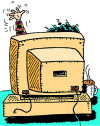Brandy redux
Posts: 2376
Joined: 2/7/2007
Status: offline

|
Hard drive search: WinVista
The preferred method for uninstalling software in WinVista is to go to Control Panel, select 'Programs and Features', click on the name of the program which is to be uninstalled, then click on 'Uninstall' at the top of the screen. Then, follow through with whatever steps are required to complete the uninstall process.
NOTE: If you don't see 'Uninstall' at the top of the screen (between 'Views' and 'Change'), restart the computer then try the process again.
After the uninstall process is completed, the next thing to do would be to open Windows Explorer, go to C:\Program Files\, then look for a folder which matches the name of the program that was just uninstalled. If you find a folder which EXACTLY matches that name, you'll want to delete that entire folder - because until that folder is removed, the program is not completely uninstalled.
Then, if you want to make sure that all files and folders related to that program have been removed, it will be necessary to perform a search of the entire hard drive.
Following are the recommended steps for performing a search of a WinVista hard drive.
First, however, a little explanation is required of the Search process in WinVista. When WinVista was first released, it was possible to place a 'Search' button in the Start menu. When SP 1 was released, the 'Search' button was gone. But, it was possible to perform a simple search by clicking on 'Start' then just typing the keyword for the search - without clicking on anything first. If the search didn't find anything, it was possible to go to Advanced Search by clicking on 'Search Everywhere'. However, with SP 2 installed, clicking on 'Search Everywhere' causes the default browser to open.
A simple search can be performed on a WinVista hard drive by opening Windows Explorer, clicking on the drive or folder to be searched, then typing the search word into the Search box in the upper right hand corner. However, searching in that manner will not find all files and folders which match the search word. And, searching in that manner will find items which are not related to the search word.
The method I prefer for searching a WinVista hard drive is to do an Advanced Search. However, getting to the Advanced Search window is more complicated now than it used to be:
1. Open Windows Explorer.
2. Click in the 'Search' box in the upper right hand corner of the window.
3. Type anything into that box.
4. When 'Search Tools' appears in the toolbar at the top of the window, click on the down arrow next to 'Search Tools' then select 'Search Pane' in the window that drops down.
5. When the 'Search Pane' window opens, click on the down arrow next to 'Advanced Search' in the upper right hand corner of the window.
6. When the 'Advanced Search' window opens, click on the down arrow next to the 'Location' box, then select the C:\ drive in the list that drops down. (If the program that was uninstalled was not installed in the C:\ drive, select 'Local Hard Drives'.)
7. Click in the box next to 'Include non-indexed, hidden, and system files (might be slow)' - to place a check mark in that box.
8. Type the name of the program that was uninstalled into the 'Name' box. Be sure to type the name correctly and without any misspellings.
9. Click on the 'Search' button. Then, find something else to do - because the search could take several minutes to complete.
10. When the search is completed, delete only those items which EXACTLY match the name and version number of the program that was uninstalled.
After making sure that all files, folders, icons and shortcuts have been removed from the computer, it is always a good idea to restart the computer and run a registry cleaner REPEATEDLY until no invalid registry entries are found. It is advisable to run the registry cleaner REPEATEDLY (always restart the computer before running the registry cleaner again) because fixing some invalid registry entries can cause other registry entries to become invalid.
If you are uninstalling the program because you believe that the installation is corrupt, these steps are especially important . Making sure that all files, folders, icons and shortcuts are manually deleted after an uninstall, and using a registry cleaner to remove all invalid registry entries, is the best way to ensure that all corruption has been removed.
< Message edited by Brandy redux -- 9/16/2010 4:52:51 PM >
_____________________________
For More Help: Click on the FAQ link at the top of this page Then, click on the All FAQ's button on the next page To contact me by email, please send your message to pine_97@yahoo.com |

 Printable Version
Printable Version





 New Messages
New Messages No New Messages
No New Messages Hot Topic w/ New Messages
Hot Topic w/ New Messages Hot Topic w/o New Messages
Hot Topic w/o New Messages Locked w/ New Messages
Locked w/ New Messages Locked w/o New Messages
Locked w/o New Messages Post New Thread
Post New Thread